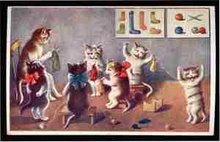An Ethnic Knitting Discovery
 BLOG BOOK TOUR STOP
BLOG BOOK TOUR STOP
Today we're visiting with Donna Druchunas to ask questions about her new book, Ethnic Knitting Discovery. Here we'll talk about the two-color knitting project I attempted from the book, what I’m calling The Buddy Project.
Dani: Donna, I grew up in Europe, seeing and wearing Nordic sweaters, and love them! I decided to try the two-color knitting in the Norway section of your book. I haven't knit using two colors much, and wanted a serious try at it. So, here's my first attempt, using your clever charts to size an ankle warmer for myself, and using one of my first attempts at spinning yarn. I had definite troubles stranding the yarn and you can see how it pulled inward. Any suggestions on how to alleviate that or is that just a common issue with beginners?

When I work in other color stranding techniques (I usually carry one color in my right hand and the second in my left), I have to be careful to pull the knitting out on the needle before I start each color. I don't know about you, but when I knit with one color, I usually let all the stitches scrunch up on the right needle after they've been knitted. You can't do that with color knitting. You have to take the time to spread out the knitting every time you change colors, especially if you've gone more than 1 or 2 stitches between color changes. It isn't as annoying as it sounds; it just becomes part of the knitting rhythm once you get used to it.
That said, I still often have to steam-press my colorwork to block it out nicely when I'm done. I have a friend who knits so beautifully with color stranded techniques that she hardly needs to block her pieces. Some day I need to sit and watch her knit for an hour or so and see if I can figure out her trick!
Dani: I also had problems with a bit of a hole when alternating between the two yarns. Is there a trick to handling that while I'm knitting?
Donna: Getting a hole when you alternate between yarns usually happens in the Intarsia technique where you're not stranding the unused color behind your work and you have a separate length of yarn for each section of color. When you use that technique, you have to make sure you twist the yarns every time you change colors -- bring the new color up from underneath the old color on the wrong side of the work. If you don't twist the colors like that, you're essentially knitting a different piece with each color.
With stranded knitting, I've never come across that problem before. If you're getting holes in stranded knitting, we should discuss that more to figure out what's going on.
Dani: My zigzag pattern didn't turn out very well, and I think I got the stitches okay. But my handspun seemed to twist tightly enough that the stitches got buried in the black Brown Sheep worsted. Or is it just because a solid contrast color might have worked better?
Donna: Definitely using two contrasting solids would make the pattern pop more. But it also makes a difference which color you carry in which hand (assuming you're using two hands for your colorwork). I usually knit looser with my right hand and get a tighter tension with my left hand, so my patterning looks neater if I carry the background color in my right hand so the pattern stitches are tidier. But sometimes that makes the pattern recede into the background.
Dani: So using Donna's tips, I cast on a fingerless glove and things seem to be working better! You can take a peek at it and read about charting adventures, cutting up your knitting (gasp) and information about books in Donna’s future at the Blog Book Tours site where we continue our conversation.
To buy the book, click here.
To read a bit more about Donna's publisher, Nomad Press, and the Green Press Initiative go here.




No comments:
Post a Comment